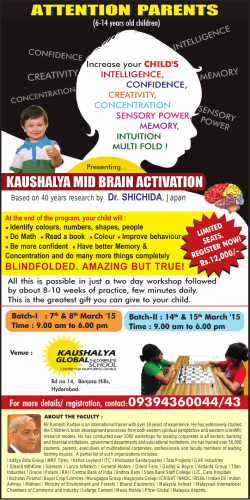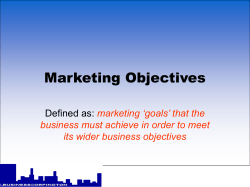
Service Strategy
Service Strategy Learning Objectives Formulate a strategic service vision. Describe how a service has addressed each element in the strategic service concept. Discuss the competitive environment of services. Describe how a service competes using the three generic service strategies. Discuss the service purchase decision. Discuss the competitive role of information Explain the role of the virtual value chain in service innovation. Discuss the limits in the use of information Strategic Service Vision Target Market Segments What are common characteristics of important market segments? What dimensions can be used to segment the market, demographic, psychographic? How important are various segments? What needs does each have? How well are these needs being served, in what manner, by whom? Strategic Service Vision Service Concepts What are important elements of the service to be provided, stated in terms of results produced for customers? How are these elements supposed to be perceived by the target market segment, by the market in general, by employees, by others? How do customers perceive the service concept? What efforts does this suggest in terms of the manner in which the service is designed, delivered, marketed? Strategic Service Vision Operating Strategy What are important elements of the strategy: operations, financing, marketing, organization, human resources, control? On which will the most effort be concentrated? Where will investments be made? How will quality and cost be controlled: measures, incentives, rewards? What results will be expected versus competition in terms of, quality of service, cost profile, productivity, morale/loyalty of servers? Strategic Service Vision Service Delivery System What are important features of the service delivery system including: role of people, technology, equipment, layout, procedures? What capacity does it provide, normally, at peak levels? To what extent does it, help insure quality standards, differentiate the service from competition, provide barriers to entry by competitors? Service Design Elements Structural: Delivery system (front & back office) Facility design (aesthetics, layout) Location (competition, site characteristics) Capacity planning (number of servers) Managerial Service encounter (culture, empowerment) Quality (measurement, guarantee) Managing capacity and demand (queues) Information (data collection, resource) Competitive Environment of Services Relatively Low Overall Entry Barriers Economies of Scale Limited High Transportation Costs Erratic Sales Fluctuations No Power Dealing with Buyers or Suppliers Product Substitutions for Service High Customer Loyalty Exit Barriers Competitive Service Strategies (Overall Cost Leadership) Seeking Out Low-cost Customers Standardizing a Custom Service Reducing the Personal Element in Service Delivery (promote self-service) Reducing Network Costs (hub and spoke) Taking Service Operations Off-line Competitive Service Strategies (Differentiation) Making the Intangible Tangible (memorable) Customizing the Standard Product Reducing Perceived Risk Giving Attention to Personnel Training Controlling Quality Note: Differentiation in service means being unique in brand image, technology use, features, or reputation for customer service. Competitive Service Strategies (Focus) Buyer Group: (e.g. USAA insurance and military officers) Service Offered: (e.g. Shouldice Hospital and hernia patients) Geographic Region: (e.g. Austin Cable Vision and TV watchers) Customer Criteria for Selecting a Service Provider Availability Convenience Dependability Personalization Price Quality Reputation Safety Speed (24 hour ATM) (Site location) (On-time performance) (Know customer’s name) (Quality surrogate) (Perceptions important) (Word-of-mouth) (Customer well-being) (Avoid excessive waiting) Service Purchase Decision Service Qualifier: To be taken seriously a certain level must be attained on the competitive dimension, as defined by other market players. Examples are cleanliness for a fast food restaurant or safe aircraft for an airline. Service Winner: The competitive dimension used to make the final choice among competitors. Example is price. Service Purchase Decision (cont.) Service Loser: Failure to deliver at or above the expected level for a competitive dimension. Examples are failure to repair auto (dependability), rude treatment (personalization) or late delivery of package (speed). Competitive Role of Information in Services Strategic Focus Competitive Use of Information On-line Off-line (Real time) (Analysis) Creation of barriers to entry: Data base asset: External Reservation system Selling information (Customer) Frequent user club Development of services Switching costs Micro-marketing Revenue generation: Productivity enhancement: Internal Yield management Inventory status (Operations) Point of sale Data envelopment Expert systems analysis (DEA) The Virtual Value Chain Marketplace vs Marketspace Creating New Markets Using Information (Gather, Organize, Select, Synthesize, and Distribute) Three Stage Evolution • 1st Stage (Visibility): See physical operations more effectively with information – Ex. USAA “paperless operation” • 2nd Stage (Mirroring Capability): Substitute virtual activities for physical – Ex. USAA “automate underwriting” • 3rd Stage (New Customer Relationships): Draw on information to deliver value to customer in new ways – Ex. USAA “event oriented service” Limits in the Use of Information Anti-competitive (Barrier to entry) Fairness (Yield management) Invasion of Privacy (Micro-marketing) Data Security (Medical records) Reliability (Credit report) America West Airlines Generic Competitive Strategy Target Entire Market Market Segment Strategic Advantage Low cost Uniqueness Overall cost Differentiation leadership Focus America West Airlines Competitive Features Service Qualifiers: Service Winners: Service Losers: America West Airlines Strategic Service Concept Delivery System: Location: Facility Design: Capacity Planning America West Airlines Strategic Service Concept (cont.) Service Encounter: Quality: Managing Capacity and Demand: Information: America West Airlines Positioning CABIN SERVICE Full Service PREFLIGHT SERVICE Inconvenient Convenient No Amenities Mrs. Fields Strategic Use of Information Strategic Focus Competitive Use of Information On-line Off-line (Real time) (Analysis) Creation of barriers to entry: Data base asset: External (Customer) Revenue generation: Internal (Operations) Productivity enhancement: Mrs. Fields Management Information System Advantages Disadvantages Mrs. Fields Questions How might the MIS contribute to a reported 100% turnover of store managers? Will the MIS support or inhibit the growth of outlets (domestic and overseas)? Alamo Drafthouse Positioning FOOD QUALITY Good MOVIE SELECTION Few Many Poor Alamo Drafthouse Strategic Service Vision Target market segments Service concept Operating strategy Service delivery system Alamo Drafthouse Winning Customers Qualifiers Service winners Service losers Alamo Drafthouse Profitability Recommendations Discussion Topics Give examples of service firms that use both the strategy of focus and differentiation and the strategy of focus and overall cost leadership. Use the service design elements for a service of your choice to illustrate how all eight elements support the service strategy. What ethical issues are associated with micro-marketing? For each of the three generic strategies (i.e., cost leadership, differentiation, and focus) which of the four competitive uses of information is most powerful? Interactive Class Exercise The class divides and debates the proposition “Frequent flyer award programs are or are not anticompetitive.”
© Copyright 2025





















